
The spectacled bear, also known as the South American bear, Andean bear, Andean short-faced bear or mountain bear and locally as jukumari, ukumari (Quechua) or ukuku, is a species of bear native to the Andes Mountains in northern and western South America. It is the only living species of bear native to South America, and the last remaining short-faced bear. Its closest relatives are the extinct Tremarctos floridanus, and the giant short-faced bears, which became extinct at the end of the Pleistocene around 12,000 years ago. The diet of the spectacled bear is mostly herbivorous, but it occasionally engages in carnivorous behavior. The species is classified as Vulnerable by the IUCN because of habitat loss.
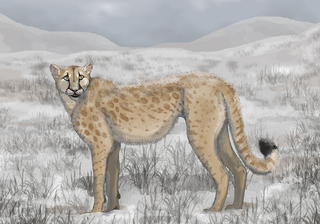
Miracinonyx is an extinct genus of felids belonging to the subfamily Felinae that was endemic to North America from the Pleistocene epoch and morphologically similar to the modern cheetah, although its apparent similar ecological niches have been considered questionable due to anatomical morphologies of the former that would have limited the ability to act as a specialized pursuit predator. The genus was originally known from fragments of skeletons, but nearly complete skeletons have been recovered from Natural Trap Cave in northern Wyoming.
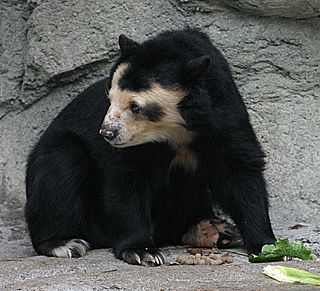
Tremarctos is a genus of the bear subfamily Tremarctinae, endemic to Americas from the Pliocene to recent. The northern species, the Florida short-faced bear, became extinct 11,000 years ago. The sole living Tremarctos species is the South American spectacled bear.

Castoroides, or giant beaver, is an extinct genus of enormous, bear-sized beavers that lived in North America during the Pleistocene. Two species are currently recognized, C. dilophidus in the Southeastern United States and C. ohioensis in most of North America. C. leiseyorum was previously described from the Irvingtonian age but is now regarded as an invalid name. All specimens previously described as C. leiseyorum are considered to belong to C. dilophidus.

The Tremarctinae or short-faced bears is a subfamily of Ursidae that contains one living representative, the spectacled bear of South America, and several extinct species from four genera: the Florida spectacled bear, the North American giant short-faced bears Arctodus, the South American giant short-faced bear Arctotherium as well as Plionarctos(P. edensis and P. harroldorum), which is thought to be ancestral to the other three genera. Of these, the giant short-faced bears may have been the largest ever carnivorans in the Americas. The group is thought to have originated in eastern North America, and then invaded South America as part of the Great American Interchange. Most short-faced bears became extinct at the end of the Pleistocene.

Armbruster's wolf is an extinct species that was endemic to North America and lived during the Irvingtonian stage of the Pleistocene epoch, spanning from 1.9 Mya—250,000 years BP. It is notable because it is proposed as the ancestor of one of the most famous prehistoric carnivores in North America, the dire wolf, which replaced it.
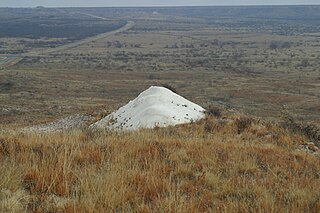
Mount Blanco is a small white hill — an erosional remnant — located on the eastern border of the Llano Estacado within Blanco Canyon in Crosby County, Texas. With Blanco Canyon, it is the type locality of the early Pleistocene Blanco Formation of Texas and Kansas, as well as the Blancan fauna, which occurs throughout North America. Mount Blanco is a Late Blancan age site, and is associated with other Late Blancan sites from Texas such as Red Light and Hudspeth local faunas from Hudspeth County, and the Cita Canyon fauna from Randall County.
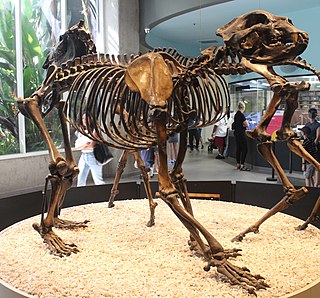
Arctodus is an extinct genus of short-faced bear that inhabited North America during the Pleistocene. There are two recognized species: the lesser short-faced bear and the giant short-faced bear. Of these species, A. simus was larger, is known from more complete remains, and is considered one of the most charismatic of North America's megafauna. A. pristinus was largely restricted to the Early Pleistocene of the Eastern United States, whereas A. simus had a broader range, with most finds being from the Late Pleistocene of the United States, Mexico and Canada. A. simus evolved from A. pristinus, but both species likely overlapped in the Middle Pleistocene. Both species are relatively rare in the fossil record.
The Irvingtonian North American Land Mammal Age on the geologic timescale is the North American faunal stage according to the North American Land Mammal Ages chronology (NALMA), spanning from 1.9 million – 250,000 years BP. Named after an assemblage of fossils from the Irvington District of Fremont, California, the Irvingtonian is usually considered to overlap the Lower Pleistocene and Middle Pleistocene epochs. The Irvingtonian is preceded by the Blancan and followed by the Rancholabrean NALMA stages.
The Rancholabrean North American Land Mammal Age on the geologic timescale is the North American faunal stage according to the North American Land Mammal Ages chronology (NALMA), typically set from less than 240,000 years to 11,000 years BP, a period of 0.229 million years. Named after the famed Rancho La Brea fossil site in Los Angeles, California, the Rancholabrean is characterized by the presence of the genus Bison in a Pleistocene context, often in association with other extinct Pleistocene forms such as Mammuthus. The age is usually considered to overlap the late Middle Pleistocene and Late Pleistocene epochs. The Rancholabrean is preceded by the Irvingtonian NALMA stage, and it is succeeded by the Santarosean age.

Canis edwardii, also known as Edward's wolf, is an extinct species of wolf in the genus Canis which was endemic to North America three million years ago from the Late Blancan stage of the Pliocene epoch and was extinct by the end of the Irvingtonian stage of the Pleistocene epoch.
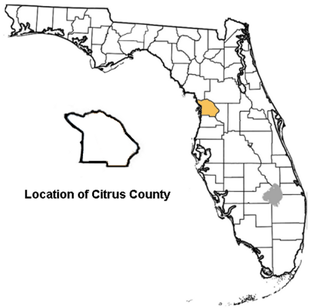
The Inglis quarry or Inglis quarry sites 1A and 1C are assemblages of vertebrate fossils dating from the Pleistocene ~1.8 Mya—300,000 years ago, located in the phosphate quarries near the town of Inglis, Citrus County, northern Florida.
The Port Kennedy Bone Cave is a limestone cave in the Port Kennedy section of Valley Forge National Historical Park, Pennsylvania, USA. The Bone Cave "contained one of the most important middle Pleistocene fossil deposits in North America".
Plionarctos is an extinct genus of bear endemic to North America from the Miocene to the Pliocene, ~10.3—3.3 Mya, existing for about 7 million years.
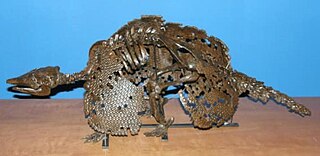
Pachyarmatherium is a genus of extinct large armadillo-like cingulates found in North and South America from the Pliocene and Pleistocene epochs, related to the extant armadillos and the extinct pampatheres and glyptodonts. It was present from 4.9 Mya to 11,000 years ago, existing for approximately 4.889 million years.

The Haile Quarry or Haile sites are an Early Miocene and Pleistocene assemblage of vertebrate fossils located in the Haile quarries, Alachua County, northern Florida. The assemblage was discovered during phosphate mining, which began in the late 1940s. Haile sites are found in the Alachua Formation. Two sites within the Ocala Limestone yielded Upper Eocene Valvatida and mollusks.
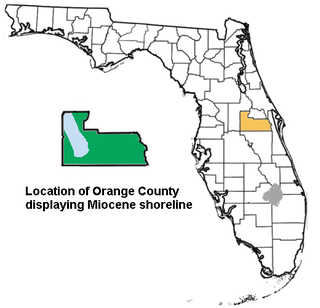
The Orange County paleontological sites are assemblages of Late Pleistocene vertebrates occurring in Orange County, Florida.

Arctotherium is an extinct genus of the Pleistocene short-faced bears endemic to Central and South America. Arctotherium migrated from North America to South America during the Great American Interchange, following the formation of the Isthmus of Panama during the late Pliocene. The genus consists of one early giant form, A. angustidens, and several succeeding smaller species, which were within the size range of modern bears. Arctotherium was adapted to open and mixed habitat. They are genetically closer to the spectacled bear, than to Arctodus of North America, implying the two extinct forms evolved large size in a convergent manner.

Tapirus veroensis is an extinct tapir species that lived in the area of the modern eastern and southern United States during the Pleistocene epoch (Irvingtonian-Rancholabrean). Tapirus veronensis is thought to have gone extinct around 11,000 years ago.

Capromeryx was a genus of dwarf pronghorns (Antilocapridae) that originated in North America during the Pliocene about 5 million years ago. The closest living relative and only surviving member of the family is the North American pronghorn.
















